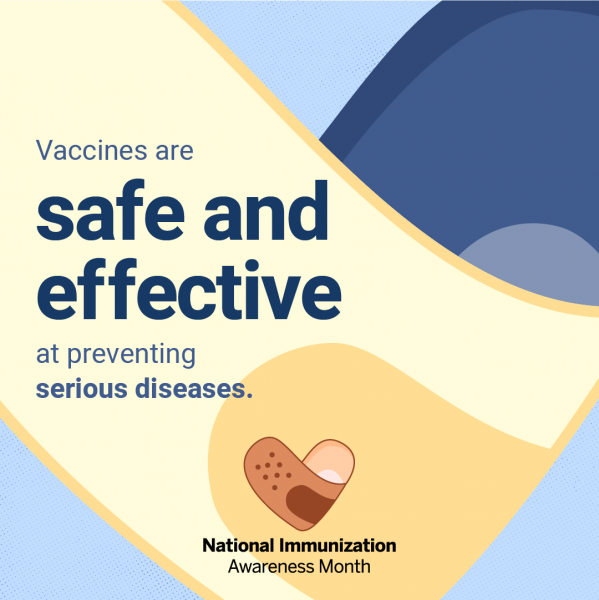August is National Immunization Awareness Month (NIAM), dedicated to highlighting the importance of immunizations across the lifespan. Immunizations have been in the spotlight for the past eight months as multiple COVID-19 vaccines have been granted Emergency Use Authorization (EUA). During this time, local health departments (LHDs) have been tirelessly working to ensure the COVID-19 vaccines are available to all in their jurisdiction. They have implemented many new and innovative practices as well as utilized existing practices.
Key to the implementation of practices has been the immunization professionals at LHDs, including those who serve on NACCHO’s Immunization Workgroup (IZWG). The IZWG is comprised of immunization professionals from across the United States. The members of the IZWG have spent the pandemic deeply involved in their LHD’s response, including serving on incident command structures, planning and preparing for vaccines, coordinating vaccination clinics, and working with partners to ensure equitable vaccine access. At the end of the 2020-2021 IZWG year, the members reflected and identified key lessons learned through the COVID-19 response. Those lessons learned are highlighted below. We hope these lessons will help inform and guide any future public health emergencies, particularly those requiring vaccinations.
- Access and Messaging: Begin identifying high-need areas and populations early and plan messaging campaigns addressing their needs and questions. Campaigns should link individuals to information they need and help them identify locations to get vaccinated. Plan to hold mobile, walk-up, and drive-through vaccine clinics where these populations can easily access them.
- Communication: Ensure there is continuous communication at the federal, state, and local levels. LHDs would benefit from guidance from the federal and state levels. In addition, LHDs should be involved in the development of their state’s plan, particularly plans for vaccine phasing and vaccine data management.
- Funding: There needs to be a greater focus on, and investment in, building public health infrastructure before a public health emergency in order for health departments to adequately respond and serve their community.
- Partnerships: Formal partnerships between public health and private health systems, including data sharing agreements, will help to get a more accurate picture of who has been vaccinated in a community. For communities that reside on state borders, a mechanism for cross-border data sharing should be used to identify community members that may have been vaccinated across state lines. Standardized processes for clinic operations with multiple teams and providers need to be defined early. Key community partnerships should be fostered and sustained before the threat of a public health emergency. Partner with organizations that can assist in reaching priority populations using culturally appropriate tactics.
- High-Priority Populations: High-priority groups such as teachers, essential workers, and first responders, should be vaccinated in conjunction with long-term care facility staff and residents.
- Vaccine and Ancillary Equipment Supply: More notice to LHDs about when they will receive vaccines, how much, and what type is vital for them to better plan how to distribute vaccines. Additionally, federal, state, and local departments should be prepared with greater stockpiles of PPE and other ancillary supplies in preparation for public health emergencies.
- Vaccination Registration System: Before vaccines are distributed, identify or create a coordinated and streamlined vaccination registration system for all partners to use. Prepare multiple ways to register for those who do not have internet access or do not feel comfortable registering online. Consider using existing hotlines to assist with registration.
- Workforce: Hire and train people to work in vaccine clinics prior to needing them. During COVID, many LHDs experienced staffing shortages, particularly when operating mass clinics. Because of shortages, many staff were overworked and suffered extreme burnout. This could be helped by mandating the activation of the National Guard earlier in the vaccine roll-out.
Though we are still focused on the COVID-19 response, the IZWG wanted to ensure the lessons learned from early in the pandemic were not lost. Planning and implementing mass vaccination efforts can be complicated, and we hope these lessons learned will be applied to future efforts to help prepare for efficient and equitable vaccine distribution from the beginning.
To assist with many of the practices highlighted above, members of NACCHO’s IZWG encourage LHD immunization programs to utilize the resources provided during NIAM. These resources can assist with access and messaging, communications, partnerships, and more. Read more about NIAM and the resources available here.
NACCHO and the Immunization Program wish to sincerely thank the following 2020-2021 IZWG members for their contributions to this article and their continued support, leadership, and dedication to the field of public health and immunization: Aimee Snavely, Christine Lees, Jacob Mbafor, Jennifer Roth, Judith Shlay, Kathy Cavin, Libby Page, Lissette McNulty, Robert Benjamin, Sean Dade, Tiffany Tate, and Felicia Fredricks. A special thanks to members of the Metro Denver Partnership for Health who also contributed lessons learned to this blog post.
